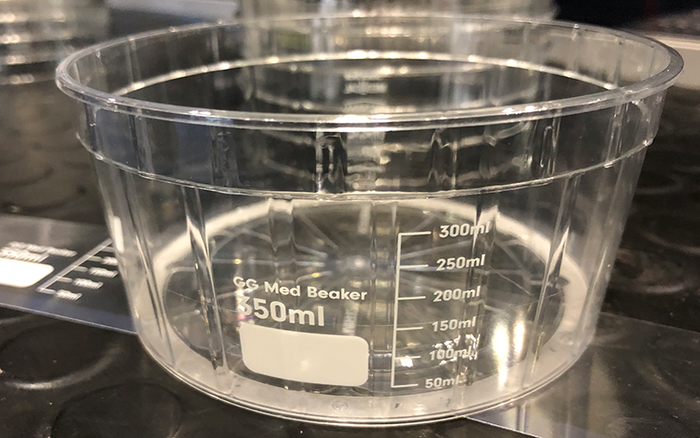
PET ‘Power Couple’ Pushes Recycling to the Max
Polypropylene is a polymer seeing a lot of positive traction in food packaging including food cups. That’s due to PP’s material’s sustainability and recyclability back into food-grade resin.
A new twist in packaging introduced at NPE2024 looks to get in on that action using tried-and-true PET.
The innovation uses that most widely recycled polymer in a source-reduced, thin-wall cup that’s paired with a PET film applied via in-mold labeling (IML). The result is complete and seamless recyclability for the packaging. The PET cup offers barrier and recycling advantages versus PP — US recycling rates for PET hover around 30% — while directly addressing the rPET shortage due to high demand by major brands.
Two key partners in the development are StackTeck Systems and Netstal Machinery.
The PET cup resin was supplied by Eastman; the 100% PET IML labels are supplied by MCC Verstraete.
The cup is formed using injection molding, which was the central challenge of the entire project. And that’s where StackTech’s know-how made the difficult thin-walling possible by adjusting hot-runner technology made for high-pressure, short-time molding.
The result? “The PET cup uses 15% less material versus a comparable PP cup,” says Jordan Robertson, StackTeck Systems VP business development and marketing.

RICK LINGLE
It also offers a superior barrier compared to PP.
Robertson also points out that PET is denser, so it is 15-20% heavier than a similar PP cup.
The 4 ½-inch diameter cup size was chosen because it’s a standard offering for dairy products such as yoghurt and cottage cheese, according to Robertson.
“It‘s getting more than a little interest from customers,” Robertson offers.
The research and development began in mid-2023, he adds.
More processing and polymer details for the technically minded.
StackTeck claims the injection-molding technology delivers an unprecedented level of thin-walling technology. The heart of the solution combines its Thin Recess Injection Molding (TRIM) with a set of seven sequentially controlled valve gates to yield the lightest part of this type ever molded.
The hot runner for the mold uses Yudo’s ISOTM technology. This enables tightly spaced valve gated drops on the bottom of the container, while incorporating independent control of valve gate timing to suit optimal filling of this ultra-thin part. The hot runner is custom designed to be suitable for high pressure injection, with thermal profiled nozzles and incorporating a balanced thermal management approach.
The polymeric ingredients, two types of PET resin, are equally crucial and point to a more recyclable future.
“We set out to establish a new standard in molding PET containers using at least 30% content of hard-to-fill PET with a high IV level mixed with a high volume, easier filling low IV PET resin with the intention that customers would be able to run the same part using 30% rPET,” says Vincent Travaglini, StackTeck CEO. “Some customers on the PET preform side of the business are running 100% rPET for beverage applications, and so we’re pointing the way towards adding post-consumer material for thin-wall containers, while adding advantages in material strength and clarity.”
The resins included Eastman Eastar EN001 resin that has an intrinsic viscosity (IV) level of 0.80 dL/g as well as EN058 that has an easier filling IV level of 0.58 dL/g.

Leave a Reply